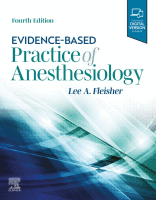Physical Address
304 North Cardinal St.
Dorchester Center, MA 02124

INTRODUCTION Perioperative acute kidney injury (AKI) is defined as a new onset of AKI within 7 days after surgery according to the Kidney Diseases: Improving Global Outcomes (KDIGO) criteria. It is associated with substantial short- and long-term complications, including, but…

INTRODUCTION The prevalence of diabetes mellitus in the United States is such that in 2020, the Centers for Disease Control and Prevention (CDC) estimated that 26.9 million individuals, or 8.2% of the US population, carried a formal diagnosis of the…

## Blood transfusions remain the most common procedure performed in hospitals in the United States. With recent trial evidence supporting the use of restrictive transfusion thresholds and the rise of patient blood management programs, however, red blood cell transfusion rates…

INTRODUCTION Postoperative nausea and vomiting (PONV) are among the most common side effects associated with anesthesia and surgery. Currently, the overall incidence of PONV for all surgeries and patient populations is estimated to be 25% to 30%. Furthermore, PONV can…

INTRODUCTION A broad variety of techniques and modes of mechanical ventilation are now available to physicians, thanks to improvements in technology. For the most part, the design of these techniques is based on sound physiologic principles. Nevertheless, there is limited…

INTRODUCTION Intravenous (IV) fluid therapy is known to have a major impact on surgical outcomes and, as a result, has been the focus of many clinical studies. The overall aim is to maintain normal intravascular volume, tissue fluid, and electrolytes…

INTRODUCTION Glucocorticoids have been used as adjunctive therapy in the perioperative period for decades. They have immunosuppressant and antiinflammatory effects, improve cardiovascular sensitivity to catecholamines, restore adrenal cortical function, and maintain intravascular volume. Therefore steroids may be particularly beneficial in…

INTRODUCTION Over 40 years ago during the Vietnam War, ketamine, a nonbarbiturate phencyclidine derivative, was considered an ideal “battlefield anesthetic” because it did not alter hemodynamics and had sedative, hypnotic, analgesic, and amnestic properties. , Over time, its popularity waned…

INTRODUCTION Perioperative management of hemostasis is an important topic. Both prophylactic and therapeutic replacement of coagulation factors are frequently required to minimize the risk for spontaneous or perioperative bleeding, the need for intraoperative transfusion of allogenic blood products, and the…

INTRODUCTION Emergency laparotomy is a common surgical procedure with high morbidity and mortality. There is a diverse range of underlying causes and surgical treatment for emergency laparotomy (excluding trauma and major vascular procedures), but the commonest underlying causes are intestinal…